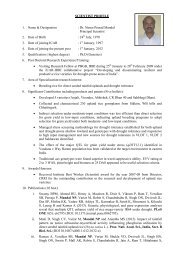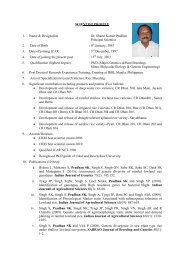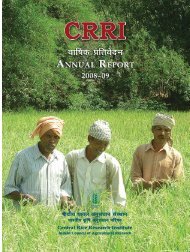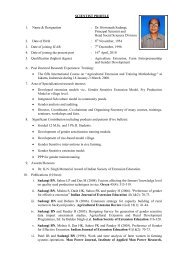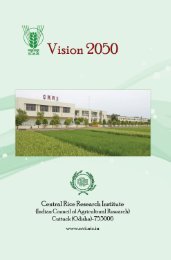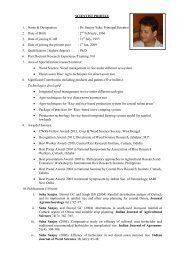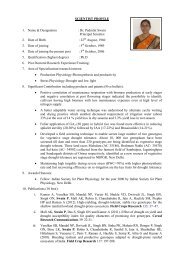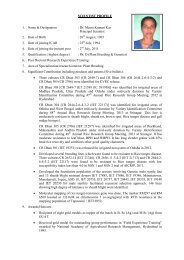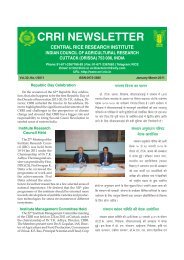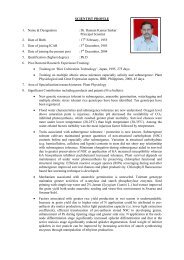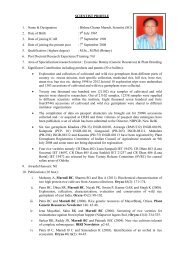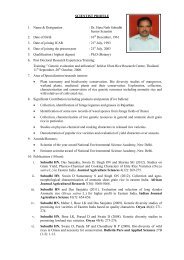Central Rice Research Institute Annual report...2011-12
Central Rice Research Institute Annual report...2011-12
Central Rice Research Institute Annual report...2011-12
Create successful ePaper yourself
Turn your PDF publications into a flip-book with our unique Google optimized e-Paper software.
Fig. 4.<br />
was 5.30 t ha -1 in the wet season, it was reduced to<br />
about 2.20 t ha -1 due to stunted growth, reduction in<br />
panicle length, grains per panicle and 1000 seed weight;<br />
another reason for the reduced yield could be the shorter<br />
crop duration observed during the dry season. This<br />
indicates that the rice Aghoni is not suitable for cultivation<br />
at Cuttack in dry season.<br />
The data on quality of milled rice of Aghoni indicated<br />
that the grains were medium slender type with<br />
good head rice recovery (64.5%). The alkali spreading<br />
value (6.0) and water uptake value (310 ml 100g -1 ) were<br />
a little on the higher side whereas, the amylose content<br />
was quite low (4.65%), which classifies Aghoni as a<br />
very low amylose rice (2-9% amylose). The grain characteristics<br />
remained largely unchanged when grown<br />
in wet/dry season.<br />
The soaking time (time required by parboiled grains<br />
to become as soft as cooked after soaking in water of<br />
normal temperature) of Aghoni increased from 40 min<br />
in 2008 to 90 min in 2011 indicating that the climatic/<br />
soil conditions at Cuttack do not suit it at least with<br />
respect to maintaining the soaking time.<br />
Standardization of a laboratory method for<br />
quantifying total carbonyl content of rice as<br />
an indicator of aroma<br />
A small arrangement was set up to measure the total<br />
carbonyl content of scented rice grains by a titrimetric<br />
method. The carbonyl compounds released by digestion<br />
of grain starch were driven to a flask containing<br />
alkaline KMnO 4<br />
. The unreacted KMnO 4<br />
was treated<br />
with iodine solution and titrated against 0.02N Na 2<br />
S 2<br />
O 3<br />
.<br />
Though lesser volumes of Na 2<br />
S 2<br />
O 3<br />
solution were required<br />
for scented grains (Basmati and Dubraj) compared<br />
to the non scented types (Vandana and Gayatri),<br />
however, the data on volume of Na 2<br />
S 2<br />
O 3<br />
solution required<br />
were not reproducible.<br />
Biochemical basis of grain quality<br />
enhancement through organic management<br />
practices<br />
The rice variety Geetanjali was grown with different<br />
organic sources of nutrients. The treatments were<br />
control, FYM, green manure (Sesbania aculeata), FYM +<br />
green manure (1:1 on N basis), FYM + Azolla (1:1 on N<br />
basis), crop residue (5 t ha -1 ) + Sesbania aculeata, Azolla +<br />
Sesbania aculeata (1:1 on N basis), crop residue (2.50 t<br />
ha -1 ) + Sesbania aculeata. The 2, 2-diphenyl-1-<br />
picrylhydrazyl free radical (DPPH) scavenging activity<br />
varied from 68.42 % to <strong>12</strong>9.48% and was higher<br />
(<strong>12</strong>9.48%) in organic rather than conventional treatment<br />
(68.42%). There was very little difference between antioxidant<br />
activities of cooked rice and raw brown rice.<br />
The treatment crop residue + GM application resulted<br />
in high oil content (3.72%) followed by FYM + GM<br />
(3.22%) as compared to conventional one (2.19%).<br />
Studies on quality characteristics of parental<br />
lines and hybrids<br />
38 CRRI ANNUAL REPORT 2011-<strong>12</strong>



